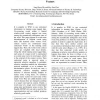Free Online Productivity Tools
i2Speak
i2Symbol
i2OCR
iTex2Img
iWeb2Print
iWeb2Shot
i2Type
iPdf2Split
iPdf2Merge
i2Bopomofo
i2Arabic
i2Style
i2Image
i2PDF
iLatex2Rtf
Sci2ools
104
Voted
COLING
2002
2002
Word Sense Disambiguation using Static and Dynamic Sense Vectors
It is popular in WSD to use contextual information in training sense tagged data. Co-occurring words within a limited window-sized context support one sense among the semantically ambiguous ones of the word. This paper reports on word sense disambiguation of English words using static and dynamic sense vectors. First, context vectors are constructed using contextual words 1 in the training sense tagged data. Then, the words in the context vector are weighted with local density. Using the whole training sense tagged data, each sense of a target word2 is represented as a static sense vector in word space, which is the centroid of the context vectors. Then contextual noise is removed using a automatic selective sampling. A automatic selective sampling method use information retrieval technique, so as to enhance the discriminative power. In each test case, a automatic selective sampling method retrieves N relevant training samples to reduce noise. Using them, we construct another sense ve...
Related Content
| Added | 17 Dec 2010 |
| Updated | 17 Dec 2010 |
| Type | Journal |
| Year | 2002 |
| Where | COLING |
| Authors | Jong-Hoon Oh, Key-Sun Choi |
Comments (0)

